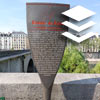
The ultimate street signs, historical sites and house numbers
 Click for a larger image
Click for a larger image  Click for all signs belonging to The History of Paris (Starck's Lollipops)
Click for all signs belonging to The History of Paris (Starck's Lollipops)
 The closest sign from this series (15 Meter): Paris - History of Paris - The Château de la Tournelle
The closest sign from this series (15 Meter): Paris - History of Paris - The Château de la Tournelle 
 345 Meter |
345 Meter |  425 Meter |
425 Meter |  447 Meter |
447 Meter |  492 Meter |
492 Meter |  558 Meter
558 Meter